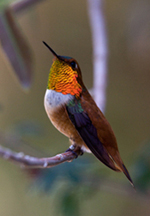
The Coati (co-AH-tee) is a relative of the raccoon with a long nose, masked face, and a striped tail. Coatis are curious and energetic, just like kids!
Coati Club News, April, 2015
It’s April and the desert is alive with activity! Plants are growing, flowers are blooming, birds are nesting, bees are buzzing, and if you look closely, you might even see a lizard warming itself on a rock. Spring has sprung! Read on to learn more about seeds that grow into plants, and the pollinators that help make it all happen!
Seeds that “Sleep”
It is so exciting so see the fields of colorful wildflowers in the spring! Wildflower seeds lying in the desert soil have to wait for the right amount of rain before they can sprout, bloom, and become beautiful. Most of this rain needs to come in the fall and winter months. Then the “sleeping seeds” will begin to slowly grow. By the time spring comes, they’re ready to burst into bloom. The flowers will produce new seeds, which will lie in the desert soil and wait months or even years, for cool temperatures and the right amount of rain to fall. Then the seeds will sprout again!
Bees, Birds, Bats, and Blossoms
How Pollinators Help Plants

© 2007 Rhonda Spencer
Who doesn’t enjoy the wonderful colors and sweet fragrances of a flower? But flowers aren’t just there for our enjoyment! The real purpose of a flower is the plant’s way of making other plants.
There are two important things to know about flowers. First, flowers contain pollen grains and egg cells, which create seeds. Second, plants are rooted in the ground- they can’t get up and move around! They need the help of something that can take pollen from one plant to another. Usually, that help comes from an animal, such as a bee, fly, butterfly, bat, moth, bird, etc. It is called a pollinator. The flower is so important because it attracts the pollinator to the plant with brightly colored petals and a sweet smell. The flower offers the animal food - sweet nutritious nectar or pollen - as well as scents or oils.

© 2010 Rhonda Spencer
Pollen is powdery and is found on the ends of long stalks in the flower. If you lightly rub a piece of black paper across the top of a flower, you should be able to see traces of the powdery pollen on the paper. When animals visit flowers in search of nectar and pollen to use as food, they pick up the pollen on their bodies and carry it with them when they move to another flower. If the flower is the same kind, and some of the pollen brushes off on it, the pollen joins with an egg cell inside the flower and a seed begins to develop. If the conditions are right, soon a plant will begin to grow!

One of three bites of food we eat is made possible because a pollinator visited a flower. Check out this link to see some of these foods and remember to thank a pollinator!
Grow a Pollen Tube: An Experiment to Try
- Soak sugar in warm water and place it in a saucer.
- Find a flower that has lots of pollen.
- Shake the pollen onto the surface of the sugar solution.
- Cover with a piece of glass or plastic wrap and set it in a warm place for several hours.
If the experiment is successful, you will be able to see little tubes growing from the pollen grains. Use a hand lens to get a better look!
Make a Pollinator
At our pollination party at Mission Gardens in March, we learned about how different kinds of flowers have different pollinators. You can make your own pollinator and flower puppets. Go to the Pollination Strategies Model Patterns midway down the Plant and Animal Partners page, print your favorite pattern, and follow the instructions.

